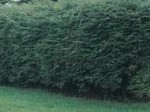 Evergreen conifers offer many features that make them desirable as a hedge. Their dense covering of needles throughout the year make an effective screen or privacy hedge and can serve as a windbreak. Many of them are cold hardy and so are especially valuable in areas where the winters are long and cold.
Evergreen conifers offer many features that make them desirable as a hedge. Their dense covering of needles throughout the year make an effective screen or privacy hedge and can serve as a windbreak. Many of them are cold hardy and so are especially valuable in areas where the winters are long and cold.
The five plants described here are mostly trees that can be used as a tall screen or pruned to make a medium sized hedge.
 ‘Yoshina’ Japanese Cedar (Cryptomeria japonica ‘Yoshina’)
‘Yoshina’ Japanese Cedar (Cryptomeria japonica ‘Yoshina’)
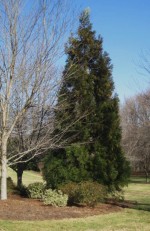 A relative of the giant sequoia of California, cryptomeria has soft sprays of foliage that are blue-green in summer and take on a tinge of reddish brown in winter. Older trees have appealing reddish-brown bark that peels of the trunk in long shreds. Trees grow 2-3’ per year and form an excellent screen with light pruning.
A relative of the giant sequoia of California, cryptomeria has soft sprays of foliage that are blue-green in summer and take on a tinge of reddish brown in winter. Older trees have appealing reddish-brown bark that peels of the trunk in long shreds. Trees grow 2-3’ per year and form an excellent screen with light pruning.
-
Height: 60’
Light: Full sun to partial shade
Soil: Rich, moist; cannot tolerate drought
Hardiness: Zones 6-8
 English Yew (Taxus baccata)
English Yew (Taxus baccata)
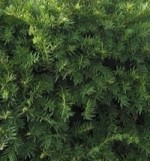 Slow growing English yew has been a favorite for hedges and topiary for many years. One of oldest English yews in America is over 200 years old and grows in Williamsburg, Virgina. The story goes that George Washington proposed to Martha Curtis under its boughs. The needs are dark glossy green above and pale green beneath.
Slow growing English yew has been a favorite for hedges and topiary for many years. One of oldest English yews in America is over 200 years old and grows in Williamsburg, Virgina. The story goes that George Washington proposed to Martha Curtis under its boughs. The needs are dark glossy green above and pale green beneath.
-
Height: 50’
Light: Sun to partial shade
Soil: Average, moist, well-drained
Hardiness: Zones 6-7 (5 with protection)
 Canadian Hemlock (Tsuga canadensis)
Canadian Hemlock (Tsuga canadensis)
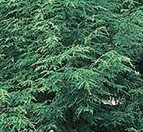 Canadian hemlock makes one of the most outstanding evergreen hedges and is used in this way in the National Cemetery at Arlington, Virginia. There are many varieties of Canadian hemlock from dwarf forms to tall forest trees but even the large ones can be kept at 5-6′ with proper pruning.
Canadian hemlock makes one of the most outstanding evergreen hedges and is used in this way in the National Cemetery at Arlington, Virginia. There are many varieties of Canadian hemlock from dwarf forms to tall forest trees but even the large ones can be kept at 5-6′ with proper pruning.
-
Height: 90’
Light: Sun to part shade
Soil: Average, moist, well-drained, slightly acidic; does not tolerate drought
Hardiness: Zones 3-7
Chinese Juniper (Juniperus chinensis)
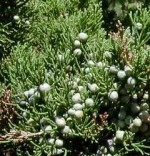 Like hollies and yews, the sexes are separate so if you want to have the delightful blue berries you have to have female plants with a male in close proximity. The berries of Chinese juniper take two years to ripen but are a little larger than the berries of other junipers such as Eastern red-cedar. There are many varieties and cultivars of Chinese junipers from ground covers to shrubs, to large trees. They also vary in shape and color.
Like hollies and yews, the sexes are separate so if you want to have the delightful blue berries you have to have female plants with a male in close proximity. The berries of Chinese juniper take two years to ripen but are a little larger than the berries of other junipers such as Eastern red-cedar. There are many varieties and cultivars of Chinese junipers from ground covers to shrubs, to large trees. They also vary in shape and color.
-
Height: 1-60’
Light: Full sun but tolerates some shade depending on the cultivar.
Soil: Average, well-drained; tolerate some dryness once established.
Hardiness: Zones 3-9
Douglas Fir (Pseudotsuga menziesii var. glauca)
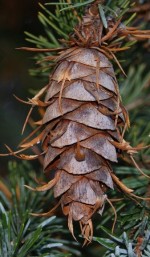 The variety that is used is a slow growing native of the Colorado mountains, not the one that that is grown for lumber in Washington, Oregon, and northern California. The unique pendulous cones and soft needles make this tree a beloved choice for a garden background screen.
The variety that is used is a slow growing native of the Colorado mountains, not the one that that is grown for lumber in Washington, Oregon, and northern California. The unique pendulous cones and soft needles make this tree a beloved choice for a garden background screen.
-
Height: 40-60
Light: Full sun
Soil: Average, well-drained
Hardiness: Zones 5-6
Most of these plants are large trees and will grow wide as well as tall. Special attention should be paid to correct plant spacing to give them the chance to develop good root systems. They all make excellent tall hedges or screens with careful pruning.
